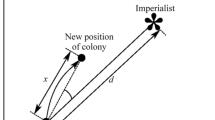Abstract
Vendor managed inventory combines inventory management and transportation. Compared to classical inventory management approaches, this strategy offers various degrees of freedom for the vendor while providing a certain service quality level for the customers. To capture the characteristics of rich real-world scenarios, our problem formulation consists of multiple customers, many products and stochastic product usages. Additionally, we also consider mixed formulations, where only a certain part of the customers is switched to a vendor managed inventory to allow a stepwise transition. We show that resupply and routing policies can be evolved autonomously for those scenarios using a simulation-based optimization approach. By combining inventory management and routing, the resulting policies aim to minimize costs and to maximize resource usage while maintaining a given service level. In order to validate our approach, we perform case studies and apply the evolved rules on a large-scale vendor managed inventory scenario for supermarkets. Furthermore, we show that our methodology can be used to perform a sensitivity analysis by considering the influence of exogenous and endogenous factors on the decision process, if a customer base should be transitioned to a vendor managed inventory.
Similar content being viewed by others
References
Adelman D (2004) A price-directed approach to stochastic inventory/routing. Oper Res 52: 499–514
Affenzeller M, Winkler S, Wagner S, Beham A (2009) Genetic algorithms and genetic programming: modern concepts and practical applications (numerical insights), 1st edn. Chapman & Hall, London
Beham A, Kofler M, Wagner S, Affenzeller M (2009) Agent-based simulation of dispatching rules in dynamic pickup and delivery problems. In: LINDI 2009. 2nd international logistics and industrial informatics, 2009, pp 1–6
Bell W, Dalberto L, Fisher M, Greenfield A, Jaikumar R, Kedia P, Mack R, Prutzman P (1983) Improving the distribution of industrial gases with an online computerized routing and scheduling optimizer. Interfaces 13: 4–23
Berman O, Larson R (2001) Deliveries in an inventory/routing problem using stochastic dynamic programming. Transp Sci 35: 192–213
Bertazzi L, Savelsbergh M, Speranza M (2007) Inventory routing. In: Golden B, Raghavan S, Wasil E (eds) The vehicle routing problem: latest advances and new challenges, operations research/computer science interfaces serices, vol 43. Springer, Berlin, pp 49–72
Beyer HG, Schwefel HP (2002) Evolution strategies—a comprehensive introduction. Nat Comput 1(1): 3–52
Clarke G, Wright JW (1964) Scheduling of vehicles from a central depot to a number of delivery points. Oper Res 12(4): 568–581
Cordeau JF, Gendreau M, Hertz A, Laporte G, Sormany JS (2005) New heuristics for the vehicle routing problem. In: Logistics systems: design and optimization, chap 9. Springer, New York, pp 279–297
Cordeau JF, Laporte G, Savelsbergh M, Vigo D (2007) Vehicle routing. In: Barnhart C, Laporte G (eds) Handbooks in operations research and management science, vol 14. Elsevier, North-Holland, pp 367–428
Dantzig GB, Ramser JH (1959) The truck dispatching problem. Manag Sci 6(1): 80–91
Eksioglu B, Vural A, Reisman A (2009) The vehicle routing problem: a taxonomic review. Comput Ind Eng 57(4): 1472–1483
Foster BA, Ryan DM (1976) An integer programming approach to the vehicle scheduling problem. Oper Res Q 27(2): 367–384
Garey MR, Johnson DS (1979) Computers and intractability: a guide to the theory of NP-completeness. W. H. Freeman & Co., New York
Gendreau M, Tarantilis CD (2010) Solving large-scale vehicle routing problems with time windows: the state-of-the-art. Technical Report CIRRELT–2010-04, CIRRELT, Montreal
Hemmelmayr V, Doerner K, Hartl R, Savelsbergh M (2009) Vendor managed inventory for environments with stochastic product usage. Eur J Oper Res 202: 686–695
Kleywegt A, Nori V, Savelsbergh M (2002) The stochastic inventory routing problem with direct deliveries. Transp Sci 36: 94–118
Magee J, Boodman D (1967) Production planning and inventory control, 2nd edn. McGraw-Hill, New York
Moin N, Salhi S (2007) Inventory routing problems: a logistical overview. J Oper Res Soc 58: 1185–1194
Neis P, Zipf A (2008) Zur kopplung von opensource, openls und optenstreetmaps in openrouteservice.org. In: AGIT 2008. Symposium fr angewandte Geoinformatik. Salzburg, Austria
Thangiah S (1999) A hybrid genetic algorithms, simulated annealing and tabu search heuristic for vehicle routing problems with time windows. In: Chambers L (eds) Practical handbook of genetic algorithms, volume III: complex structures. CRC Press, Florida, pp 347–381
Vonolfen S, Wagner S, Beham A, Kofler M, Affenzeller M, Lengauer E, Scheucher M (2010) A simulation-based approach to the vehicle routing problem. In: 22nd European modeling and simulation symposium EMSS 2010. Fes, Marokko, pp 363–368
Vos J (2005) The repast framework implemented in the .net framework. In: Proceedings of the 2005 NAACSOS conference June 26–28, Notre Dame, Indiana, pp 363–368
Wagner S (2009) Heuristic optimization software systems—modeling of heuristic optimization algorithms in the HeuristicLab software environment. PhD thesis, Johannes Kepler University, Linz, Austria
Waller M, Johnson M, Davis T (1999) Vendor-management inventory in the retail supply chain. J Bus Logist 20: 181–203
Author information
Authors and Affiliations
Corresponding author
Rights and permissions
About this article
Cite this article
Vonolfen, S., Affenzeller, M., Beham, A. et al. Simulation-based evolution of resupply and routing policies in rich vendor-managed inventory scenarios. Cent Eur J Oper Res 21, 379–400 (2013). https://doi.org/10.1007/s10100-011-0232-5
Published:
Issue Date:
DOI: https://doi.org/10.1007/s10100-011-0232-5




